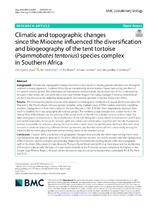| dc.contributor.author | Zhao, Z | |
| dc.contributor.author | Hofmeyr, D. M | |
| dc.contributor.author | Jordaan, A | |
| dc.contributor.author | Bester, P | |
| dc.contributor.author | Heideman, N | |
| dc.date.accessioned | 2021-09-30T11:06:53Z | |
| dc.date.available | 2021-09-30T11:06:53Z | |
| dc.date.issued | 2020 | |
| dc.identifier.citation | Zhao, Z., Heideman, N., Bester, P., Jordaan, A., & Hofmeyr, M. D. (2020). Climatic and topographic changes since the Miocene influenced the diversification and biogeography of the tent tortoise (Psammobates tentorius) species complex in Southern Africa. BMC Evolutionary Biology, 20(1). https://doi.org/10.1186/s12862-020-01717-1 | en_US |
| dc.identifier.issn | 14712148 | |
| dc.identifier.other | 10.1186/s12862-020-01717-1 | |
| dc.identifier.uri | http://hdl.handle.net/10566/6847 | |
| dc.description.abstract | Background: Climatic and topographic changes function as key drivers in shaping genetic structure and cladogenic
radiation in many organisms. Southern Africa has an exceptionally diverse tortoise fauna, harbouring one-third of
the world’s tortoise genera. The distribution of Psammobates tentorius (Kuhl, 1820) covers two of the 25 biodiversity
hotspots in the world, the Succulent Karoo and Cape Floristic Region. The highly diverged P. tentorius represents an
excellent model species for exploring biogeographic and radiation patterns of reptiles in Southern Africa.
Results: We investigated genetic structure and radiation patterns against temporal and spatial dimensions since the
Miocene in the Psammobates tentorius species complex, using multiple types of DNA markers and niche modelling
analyses. Cladogenesis in P. tentorius started in the late Miocene (11.63–5.33 Ma) when populations dispersed from
north to south to form two geographically isolated groups. The northern group diverged into a clade north of the
Orange River (OR), followed by the splitting of the group south of the OR into a western and an interior clade. The
latter divergence corresponded to the intensifcation of the cold Benguela current, which caused western aridifcation
and rainfall seasonality. In the south, tectonic uplift and subsequent exhumation, together with climatic fuctuations
seemed responsible for radiations among the four southern clades since the late Miocene. We found that each clade
occurred in a habitat shaped by diferent climatic parameters, and that the niches difered substantially among the
clades of the northern group but were similar among clades of the southern group.
Conclusion: Climatic shifts, and biome and geographic changes were possibly the three major driving forces shaping cladogenesis and genetic structure in Southern African tortoise species. Our results revealed that the cladogenesis
of the P. tentorius species complex was probably shaped by environmental cooling, biome shifts and topographic
uplift in Southern Africa since the late Miocene. The Last Glacial Maximum (LGM) may have impacted the distribution
of P. tentorius substantially. We found the taxonomic diversify of the P. tentorius species complex to be highest in the
Greater Cape Floristic Region. All seven clades discovered warrant conservation attention, particularly Ptt-B–Ptr, Ptt-A
and Pv-A | en_US |
| dc.publisher | BMC | en_US |
| dc.subject | Cladogenesis | en_US |
| dc.subject | Evolutionary driver | en_US |
| dc.subject | Miocene cooling | en_US |
| dc.subject | Refugia retracting | en_US |
| dc.subject | Biogeography | en_US |
| dc.subject | Hidden diversity | en_US |
| dc.title | Climatic and topographic changes since the Miocene influenced the diversification and biogeography of the tent tortoise (Psammobates tentorius) species complex in Southern Africa | en_US |
| dc.type | Article | en_US |

